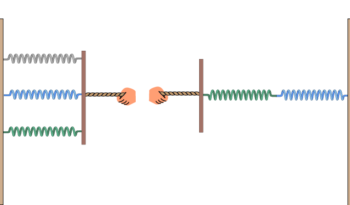There are several problems on ballistic that illustrate in a straightforward manner the application of Newton’s equations to parabolic motion. Think for example, that a projectile is launched in front of a fence of height \(h\) located at a distance \(L\) from the place of firing. We want the projectile to land on the other side of the fence. It is clear that for certain angles of firing the projectile won’t pass above the fence to the other side for any initial velocity \(v_0\). It is intuitively clear that the angle of firing has to be greater than that that makes the straight line from the cannon to the tip of the fence. At that precise angle, the initial velocity would have to be very large for the projectile to reach the other side. If we increase the angle a little bit, then we will require to give a lower initial velocity to the projectile. So we can ask what the minimum initial velocity is that allows the projectile to land on the other side of the fence and at which angle \(\theta_c\) of firing it is achieved.
For the sake of completeness let’s recall here the equations of motion:
\begin{equation}
\begin{split}
m\frac{d^2x}{dt^2}&=0\\
m\frac{d^2y}{dt^2}&=-mg,
\end{split}
\end{equation}
and their respective solutions with initial position \((x_0,y_0)=(0,0)\)
\begin{equation}
\begin{split}
x&=(v_0\cos\theta)t\\
y&=(v_0\sin\theta)t-\frac{1}{2}gt^2.
\end{split}
\end{equation}
We can plug \(t=x/(v_0\cos\theta)\) in the equation for \(y\) to get the relation
y=(\tan\theta)x-\frac{g}{2v_0^2\cos^2\theta}x^2.
\end{equation}
Minimum velocity required to pass above the fence in parabolic motion
Let’s see how to solve this problem of parabolic motion. Suppose that for a certain angle \(\theta\) and initial velocity \(v_0\), the projectile pass above the fence at a height \(H_1>h\). Then, without changing the angle, we can reduce a little bit the initial velocity. Now the projectile will pass above the fence at a height \(H_2<H_1\), but still \(H_2>h\). It is clear that, for that angle, the minimum required velocity will be that that makes the projectile to graze the tip of the fence. So, we see that for the minimum required velocity, the projectile necessarily has to graze the tip of the fence. This is equivalent to impose the condition \(y=h\) at \(x=L\) on equation (3):
h=(\tan\theta)L-\frac{g}{2v_0^2\cos^2\theta}L^2.
\end{equation}
The latter equation establishes a relation between the angle of firing \(\theta\) and the minimal initial velocity \(v_0\) necessary for the projectile to pass to the other side of the fence. We just have to calculate the derivative with respect to \(\theta\) to find the critical angle \(\theta_c\) at which the initial velocity is minimum:
0=\frac{L}{\cos^2\theta}+\frac{gL^2}{v_0^3\cos^2\theta}\frac{dv_0}{d\theta}-\frac{gL^2\sin\theta}{v_0^2\cos^3\theta}.
\end{equation}
At the critical angle \(\theta_c\) we have \(dv_0/d\theta=0\). So, the latter equation implies the relation
\begin{equation}
\tan\theta_c=\frac{v_0^2}{gL}.
\end{equation}
If we use equation (6) together with the identity \(1+\tan^2\theta=1/\cos^2\theta\) in equation (4), we get the equation
h=\frac{v_0^2}{g}-\frac{gL^2}{2v_0^2}\left(1+\frac{v_0^4}{g^2L^2}\right),
\end{equation}
that is equivalent to
\begin{equation}
h=\frac{v_0^2}{2g}-\frac{gL^2}{2v_0^2},
\end{equation}
and it can be rewritten in the form
\begin{equation}
v_0^4-2ghv_0^2-g^2L^2=0,
\end{equation}
whose solution is
\boxed{v_0=\sqrt{gh}\left(1+\sqrt{1+\left(\frac{L}{h}\right)^2}\right)^{\frac{1}{2}}}.
\end{equation}
Finally, the critical angle \(\theta_c\) to achieve this minimum velocity is obtained by plugin the latter equation in equation (6):
\boxed{\tan\theta_c=\frac{h}{L}\left(1+\sqrt{1+\left(\frac{L}{h}\right)^2}\right)}.
\end{equation}
Understanding the solution
Let’s check that the result we have obtained is consistent with what we know in special cases. Let’s for example check what these results say to us in the limit when \(L>0\) but \(h\to 0\). In this limit, equation (10) implies that \(v_0\to \sqrt{gL}\) . You can verify that limit either rigorously, or by noting that, in that limit, \(1\) can be neglected compared to \((L/h)>>1\), or remembering that equation (10) is a solution of equation (9) and then using the latter in the respective limit \(h\to0\). But, what does \(v_0\to \sqrt{gL}\) mean? You can rewrite it in the form \(\frac{v_0^2}{g}\to L\), and remember that \(v_0^2/g\) is just the maximum horizontal reach on a flat land. In other words, the minimum velocity required is that necessary just to reach the position of the fence. In the same limit, equation (11) implies \(\tan\theta_c\to 1\), which consistently implies \(\theta_c\to\pi/4\).
Now let’s check the limit when \(h>0\) but \(L\to0\), i.e. when the cannon is very close to the fence. In this case, equation (10) ( or equation (9)) implies \(v_0\to\sqrt{2gh}\). This can be rewritten in the form \((mv_0^2/2)\to mgh\), and this means that the minimum initial velocity is that that provides the kinetic energy necessary to reach the height \(h\) where the energy is potential only. In this limit, equation (11) implies \(\tan\theta_c\to\infty\), or equivalently \(\theta_c\to\pi/2\). In other words, the projectile has to be fired almost vertically upward.
A common mistake is to think that the minimum initial velocity is achieved when the projectile reaches its maximum height just at the position of the fence and that the maximum height is that of the fence. To see that this is not the case, let’s calculate the horizontal location of the maximum height, by just requiring that \(dy/dx=0\) in equation (3) (with help of the identity \(1+\tan^2\theta=1/\cos^2\theta\)). Thus the location of the maximum height is at
\begin{equation}
x=\frac{v_0^2}{g}\frac{\tan\theta_c}{1+\tan^2\theta_c},
\end{equation}
If we plug equation (6) in the latter equation, we can rearrange the result in the form
\begin{equation}
x=\frac{L}{1+\left(gL/v_0^2\right)^2}
\end{equation}
The latter is the location of the maximum height of the projectile. We see that this maximum is reached before the fence and not just above it. This means that the projectile grazes the fence when it is descending and not when it is raising.


Thanks a lot for sharing your knowledge!